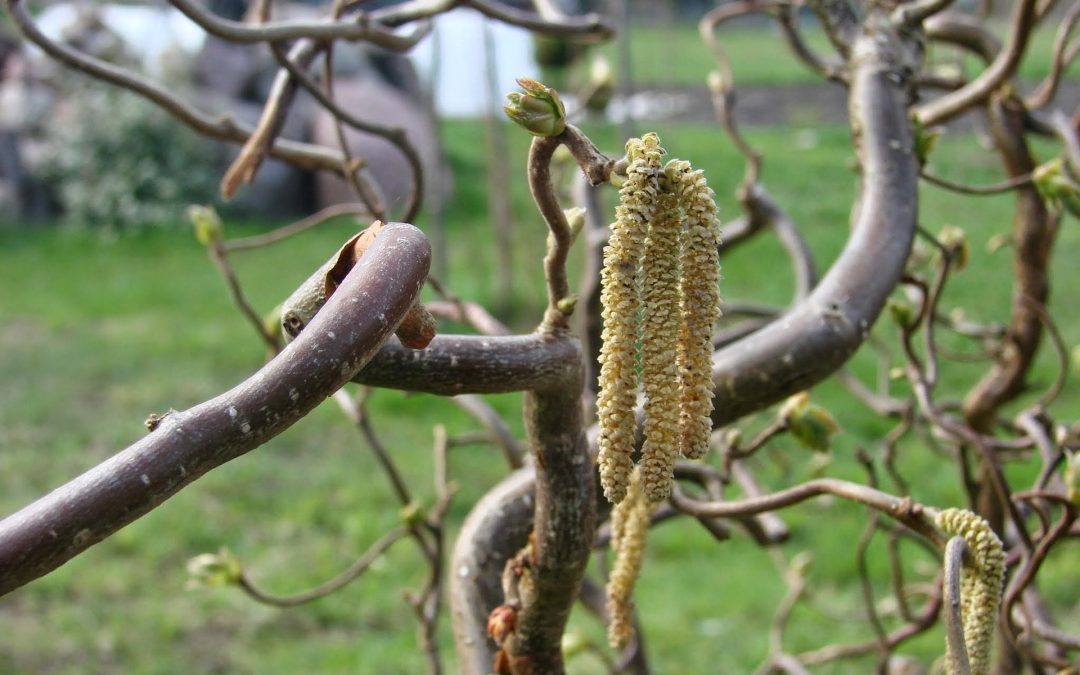
If you are looking for a focal point for a planting bed or in the yard as a standalone, the Firebird Crabapple might be a consideration. This ornamental crab reaches about 10’ h x 8-10’ w at maturity. The dense spreading deciduous has horizontally tiered branches giving the tree a formal compact look. Springtime brings tight clusters of fragrant white flowers with dark green foliage that turns yellow in the fall. Red fruit that hasn’t been eaten by the wildlife, along with the red branches and brown bark will create winter interest. As with other flowering trees, the Firebird will thrive in full sun and with well-draining soil. This particular variety of crab tree has excellent resistance to apple scab and fire-blight.

The once immensely popular Contorted Hazelnut (Corylus avellana Contorta), more commonly known as Harry Lauders Walking stick, is a show stopping plant guaranteed to amaze all who admire its beauty. While this plant is gorgeous year-round, its true beauty is shown from late fall to late spring when it has shed its leaves to reveal its oddly formed branches. In spring, as part of the Betulaceae family, the shrub produces yellow flowers, called catkins. This plant is a slow grower, reaching about 10 in height at maturity and does best in full sun to part shade. Although easy going with the ability to withstand most soil types except clay, and disease resistant, this shrub will need regular pruning to prevent the onset of suckers. Overall, any gardener young or old, beginner or experienced, can grow this plant, and should as it will become a conversational piece.

The Butterflies Magnolia (M. Acuminata x M. Denudata) is a wonderful small tree for those who adore the showy flowers magnolia trees are known for but are looking for something new and exciting. The tree blooms very early in the spring season, and the soft yellow flowers offer spectacular contrast to the well-loved pink on white of other common flowering trees. The Butterflies Magnolia has large double blooms reaching 4 to 5 inches across. Growing 25-30 tall and spreading to 10-15 ft, this tree can also offer some shade in the hot summer months. It should be planted in full sun or very light shade. This cultivar is so low maintenance, it needs almost no pruning. It can however be shaped to suit your yard best. You may also choose between a single-stem and a multi-stem variety. This cold hardy Magnolia Tree can be grown in zones 4-9. In order to ensure the healthiest tree possible, it should be grown in slightly acidic, well-draining, and nutrient soils. To protect the blooms and take advantage of as much bloom time as possible it should be planted somewhere protected from high winds, as it will severely shorten the time spent enjoying the blooms.

Wave Petunia has been well loved for decades now and never fail to dazzle viewers. While the Wave Petunia is extremely recognizable, the markets have been flooded with so many options for Petunia lovers. In order to choose the best Petunia for you it is important to understand the INSERT GOOD WORDS HERE. Wave Petunias were actually cultivated to be grown as a ground cover and not for pots! Wave Petunias are extremely aggressive growers with very extensive roots systems that make them ideal for filling in empty spaces, adding color to rocky areas, and creating borders. This also means that they can, and will, choke out all other flowers near it. When creating or buying hanging baskets, we dont recommend growing Wave Petunias in the same container as other flowers because the Petunia will kill off all other additions. In order to keep the plant blooming vigorously all summer, one should prune back 1/3 of the plant when it starts to become leggy, fertilize once every 2 weeks, and water generously. Wave Petunia can be the perfect addition to any summer garden when treated and planted properly.

Are you struggling to find the perfect flowering tree to plant in your shady lot? Look no further because the Pagoda Dogwood will be just that. This extremely low maintenance, small, flowering tree can be grown in shade, partial shade, and full sun. While it can survive in full sun, the tree prefers the shade. The Pagoda dogwood also prefers moist, acidic, well drained soils. Known for the distinct layers the branches create by growing almost parallel to the ground, this tree will look gorgeous in your yard year-round. In May, the Pagoda Dogwood will delight your senses with its fragrant white and yellow blooms. The flowers, when pollinated, will mature into fruiting bodies, however small mammals and birds love them, so they will be gone before becoming a nuisance. This tree can grow to 25 feet tall and 50 feet wide, so keep that in mind when planting.





